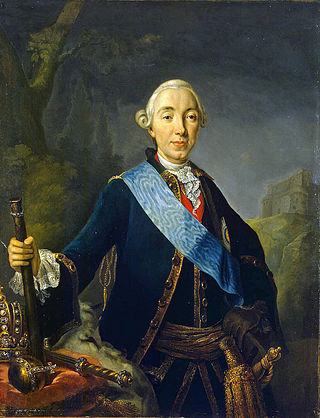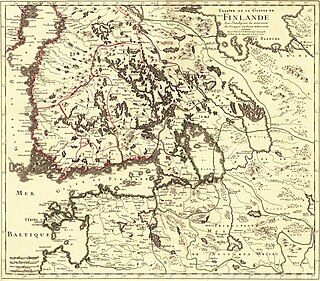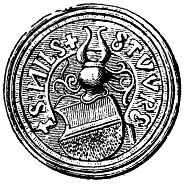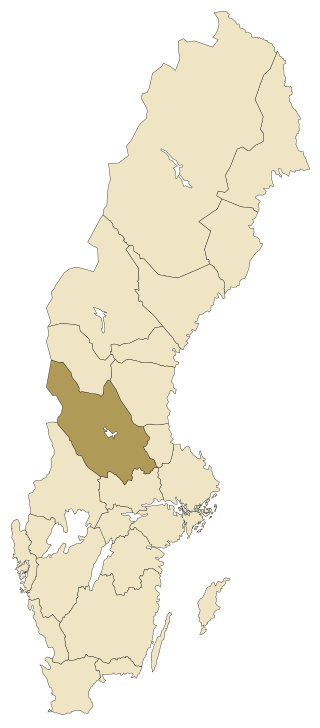
Peter III Fyodorovich was Emperor of Russia from 5 January 1762 until 9 July of the same year, when he was overthrown by his wife, Catherine II. He was born in the German city of Kiel as Charles Peter Ulrich of Schleswig-Holstein-Gottorp, the grandson of Peter the Great and great-grandson of Charles XI of Sweden.

AdolfFrederick was King of Sweden from 1751 until his death in 1771. He was the son of Christian August of Holstein-Gottorp, Prince of Eutin, and Albertina Frederica of Baden-Durlach. He was an uncle of Catherine the Great and husband to Louisa Ulrika of Prussia.

Ulrika Eleonora or Ulrica Eleanor, known as Ulrika Eleonora the Younger, reigned as Queen of Sweden from 5 December 1718 until her abdication on 29 February 1720 in favour of her husband Frederick. Following her husband's accession as King Frederick I, Ulrika Eleonora served as his queen consort until her death in 1741.

The monarchy of Sweden is centred on the monarchical head of state of Sweden, by law a constitutional and hereditary monarchy with a parliamentary system. There have been kings in what now is the Kingdom of Sweden for more than a millennium. Originally an elective monarchy, it became a hereditary monarchy in the 16th century during the reign of Gustav Vasa, though virtually all monarchs before that belonged to a limited and small number of political families which are considered to be the royal dynasties of Sweden.

The Russo-Swedish War of 1741–1743 was instigated by the Hats, a Swedish political party that aspired to regain the territories lost to Russia during the Great Northern War, and by French diplomacy, which sought to divert Russia's attention from supporting its long-standing ally the Habsburg monarchy in the War of the Austrian Succession. The war was a disaster for Sweden, which lost more territory to Russia.
In Swedish and Finnish history, the Age of Liberty was a period that saw parliamentary governance, increasing civil rights, and the decline of the Swedish Empire that began with the adoption of the Instrument of Government in 1719 and ended with Gustav III's self-coup in 1772. This shift of power from the monarch to parliament was a direct effect of the Great Northern War.

Christina Nilsdotter Gyllenstierna of Fogelvik was a Swedish noblewoman. She was married to the Swedish regent Sten Sture the Younger, and led the Swedish resistance against Christian II of Denmark after the death of her spouse. In her own lifetime she was simply referred to as Fru Kristina, but she has become known in history as Kristina Gyllenstierna because of the house of nobility to which she belonged.

Holstein-Gottorp is the historiographical name, as well as contemporary shorthand name, for the parts of the duchies of Schleswig and Holstein, also known as Ducal Holstein, that were ruled by the dukes of Schleswig-Holstein-Gottorp, a side branch of the elder Danish line of the German House of Oldenburg. Other parts of the duchies were ruled by the kings of Denmark.

Louisa Ulrika of Prussia was Queen of Sweden from 1751 to 1771 as the wife of King Adolf Frederick. She was queen mother during the reign of King Gustav III.

The Treaty of Åbo or the Treaty of Turku was a peace treaty signed between the Russian Empire and Sweden in Åbo on 18 August [O.S. 7 August] 1743 in the end of the Russo-Swedish War of 1741–1743.

The Swedish War of Liberation, also known as Gustav Vasa's Rebellion and the Swedish War of Secession, was a significant historical event in Sweden. Gustav Vasa, a nobleman, led a rebellion and civil war against King Christian II. The war resulted in the deposition of King Christian II from the throne of Sweden, effectively ending the Kalmar Union that had united Sweden, Norway, and Denmark. This conflict played a crucial role in shaping Sweden's national identity and history.

Charles Frederick, Duke of Schleswig-Holstein-Gottorp was a Prince of Sweden and Duke of Schleswig-Holstein-Gottorp and an important member of European royalty. His dynasty, the Dukes of Schleswig-Holstein-Gottorp, were a cadet branch of the ancient House of Oldenburg, which at that time was ruling Denmark-Norway. His mother was a sister of Charles XII of Sweden. Charles Frederick married a daughter of Peter the Great and became the father of the future Peter III of Russia. As such, he is the progenitor of the Russian imperial house of Holstein-Gottorp-Romanov and the patrilineal ancestor of all Russian emperors starting with Peter III, except for Catherine II.

Frederick IV was the reigning Duke of Holstein-Gottorp.

Nils Stensson Sture, born 1512, was the eldest son and heir of Sten Sture the Younger. The so-called Daljunkern, the young leader of an unsuccessful rebellion against Gustav Vasa, claimed to be Nils Sture, and it is a much-discussed question in Swedish historiography whether they really were the same person or if Daljunkern was an impostor.

The attempt to create a Kingdom of Finland in 1742 is a little-known chapter in the history of Finland. After the Russian occupation during the Russo-Swedish War (1741–1743) and vague promises of making Finland independent, Finns elected the Duke Peter of Holstein-Gottorp, who later became heir to the throne of Russia and Emperor as Peter III, as the King of Finland. However, the political situation had outgrown the idea of Finnish independence, which quickly evaporated.

Carl Henrik Wrangel, friherre Wrangel af Adinal was an officer of the Swedish Army, attaining the rank of Field Marshal.

The Dalecarlian rebellions were a series of Swedish rebellions which took place in Dalarna in Sweden: the First Dalecarlian Rebellion in 1524-1525, the Second Dalecarlian Rebellion in 1527–1528, and the Third Dalecarlian Rebellion in 1531–1533. The rebellions were conducted by the peasantry of Dalarna against the Swedish monarch, King Gustav Vasa. Mutual reasons for all three rebellions were loss of support of Gustav I among the Dalecarlian peasantry because of the economic crisis, the increased royal power, and the unpopular Swedish Reformation.
Skinnar Per Andersson from Sollerön was a farmer from Dalarna, member of the Swedish Riksdag representing parts of Dalarna and one of the key leaders of the Dalecarlian Rebellion of 1743.

Events from the year 1743 in Sweden
The Holstein Party, was the name of a political group in 18th-century Sweden which played a significant role in politics after the death of Charles XII of Sweden in 1718 and until 1727.















